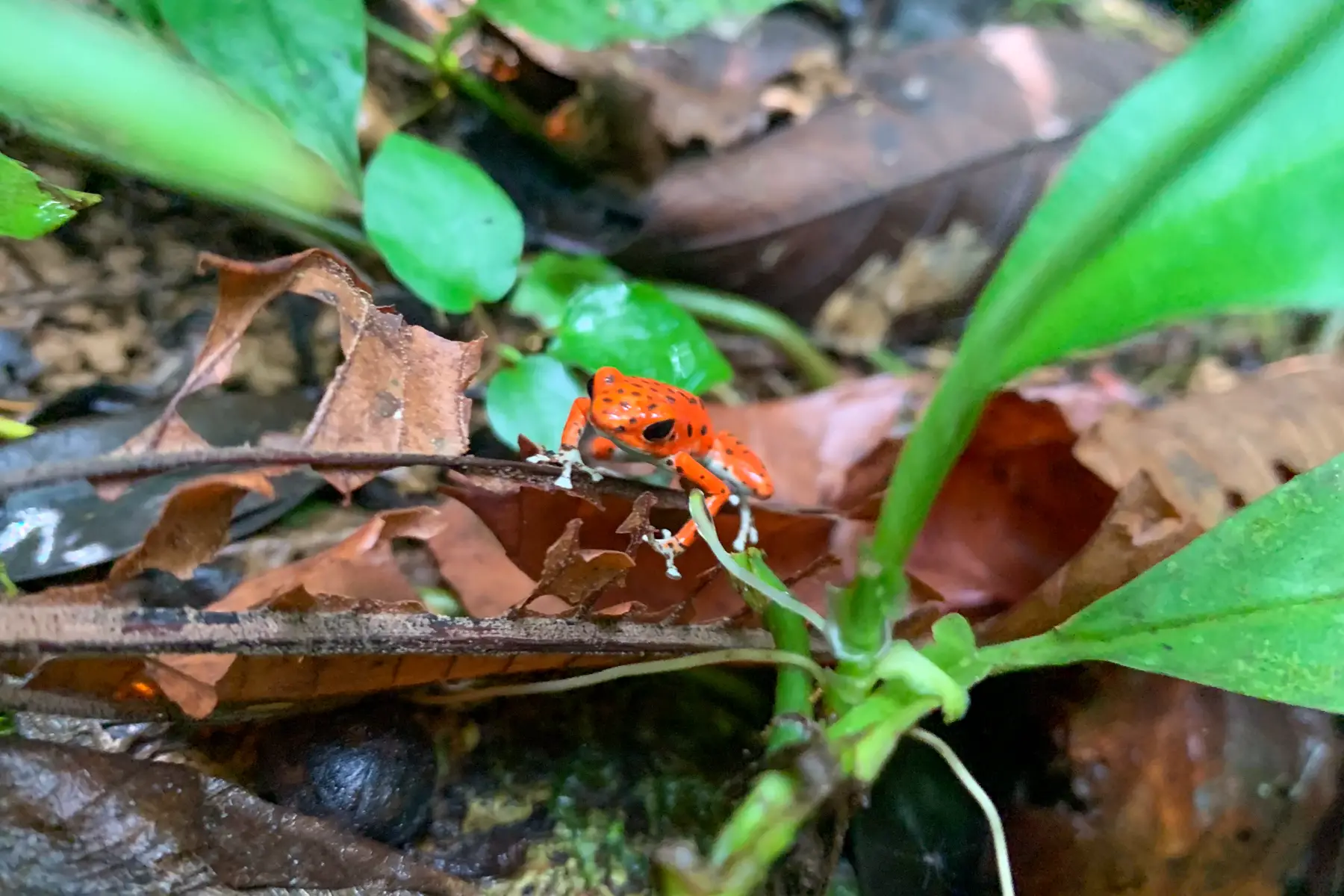Despite often being overlooked by travellers heading to neighbouring Costa Rica, Panama is a wildlife lover’s dream. Home to a variety of interesting and exciting species, no visit to the country is complete without spotting some of the incredible animals in Panama.
From poisonous frogs to majestic marine mammals and colourful birdlife, there is something for every kind of nature enthusiast here. So, make sure you’ve packed your camera and get ready to add these exciting Panamanian animals to your holiday spotter sheet!
Read more: (opens in new tab)
- Things to Do in Bocas del Toro, Panama
- Things to Do in Boquete, Panama
- Guide to the Best Hikes in Panama
Panamanian Wildlife to Look Out For
1. Humpback Whale
- Where: Pacific Coast
- Conservation status: Least concern
Panama is one of the world’s only countries which see visiting humpback whales from both the Northern and Southern Hemispheres. This means that they can be seen most of the year on the Pacific side of Panama.
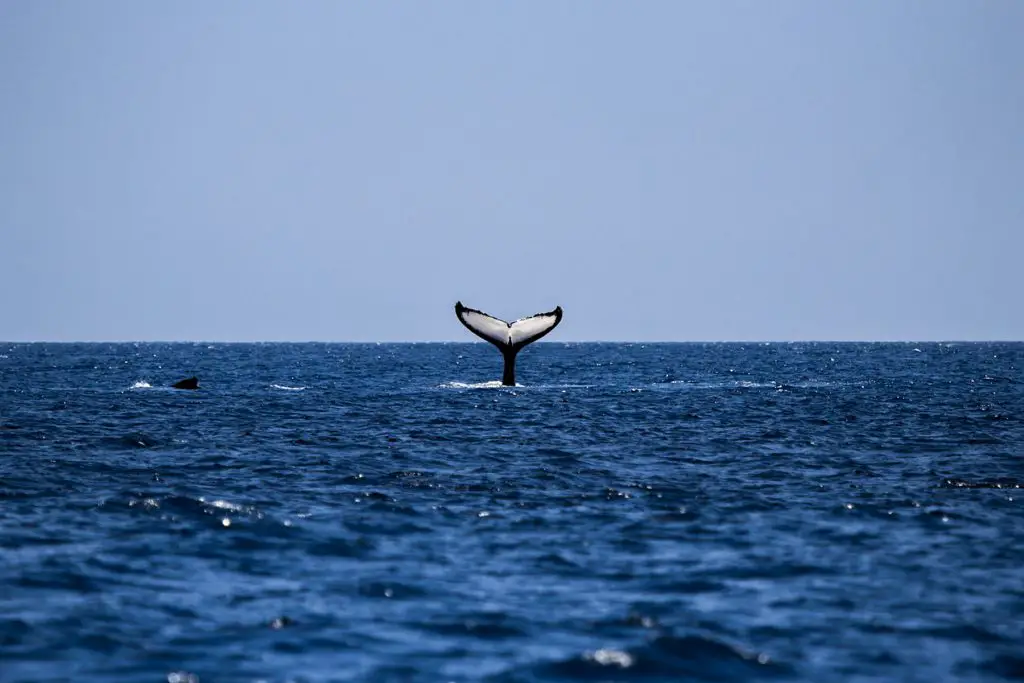
Between December to April, humpback whales travel down from North America after hanging out on the coast of California, Washington and Oregon. From July to October, it’s also possible to see the whales that migrate from Chile and Antarctica.
Considering that thousands of whales flock to Panamanian waters every year, it is no wonder that there are so many whale-spotting tours. Some of the best places to see humpback whales in Panama include Taboga Island (easily accessible as a day trip from Panama City), Coiba National Park and the Gulf of Chiriqui.
Fun Fact: The songs ‘sung’ by male humpback whales can be heard as far as 20 miles away!
2. Hoffman’s Two-Toed Sloth
- Where: Areas across the country
- Conservation status: Least concern
Known for their slow pace of life and laidback personalities, the sloth is one of the most enchanting animals in Panama.
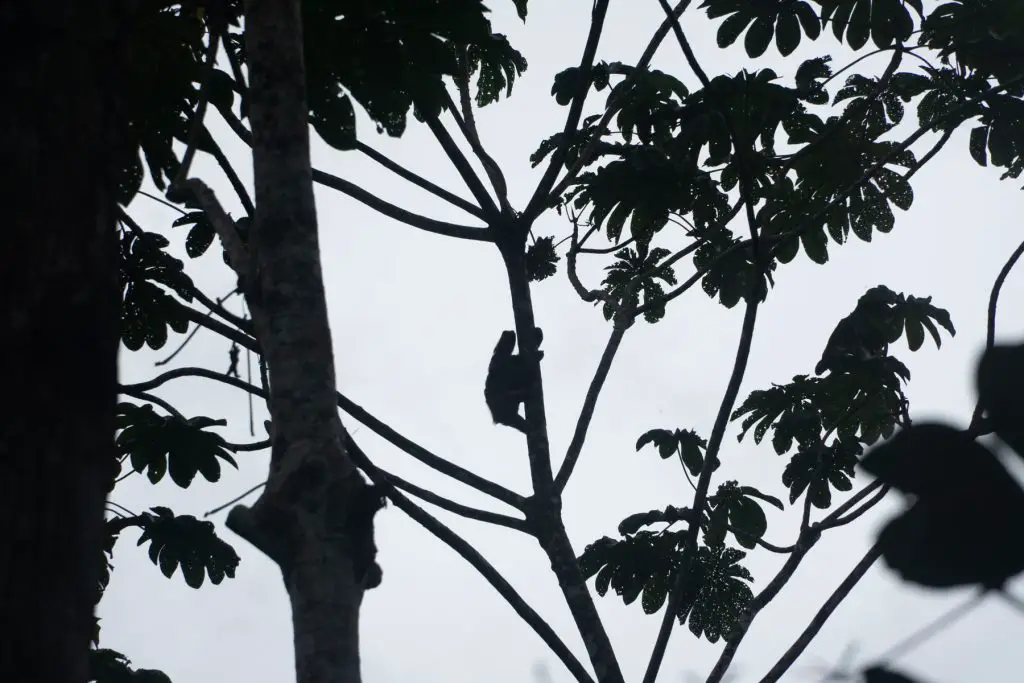
Panama is actually home to three of the six sloth species but the Hoffman’s two-toed sloth is the most common. Easily confused with monkeys from afar, sloths tend to be larger with coarse shaggy hair and dark faces.
Sloths are commonly spotted all over the country, from the jungles of Bocas del Toro to pockets of nature in the capital Panama City. You can usually find them hanging out in very tall trees. They are generally solitary animals although sometimes females will befriend one another and chill in the same tree.
Fun Fact: Sloths are nature’s yogis. They are three times stronger than humans and can lift their entire body weight from the moment they are born!
3. Harpy Eagle
- Where: Darien National Park
- Conservation status: Near threatened
This endangered species is Panama’s National Bird. It lives in the forests of the Darien Gap, one of the world’s most dangerous areas, which connects Panama to Colombia. The largest eagle in the Americas, harpy eagles stand between three and three and a half feet tall, and their talons can reach up to five inches – yikes!
Harpy eagles have white chests, grey heads and black wings. Perhaps their most distinguishing feature is their fancy head feathers. These make them look a little like they are wearing a big ruff collar – kind of like Shakespeare!
Unfortunately, these rare birds are nearly extinct in Central America. The only countries they can still be found are Panama and Costa Rica. Specialist birdwatching tours tailored to harpy eagle spotting will take tourists into Panama’s Darien Province. However, it is important to remember that the Darien area can be very dangerous and it’s only advisable to visit in the company of an experienced guide.
Fun Fact: Harpy eagles are monogamous birds and couples can stay together for a whopping 30 years!
4. Strawberry Poison-dart Frog
- Where: Bocas del Toro
- Conservation status: Least concern
This species of small poison-dart frog is found in the humid lowlands of Central America. Their name is believed to come from the hunter-gatherer practice of using the frog’s toxic secretions on the tips of darts and arrows. Scientists believe the frogs synthesise their poison from insects they eat in the wild – interestingly, skin secretions from captive frogs aren’t dangerous!
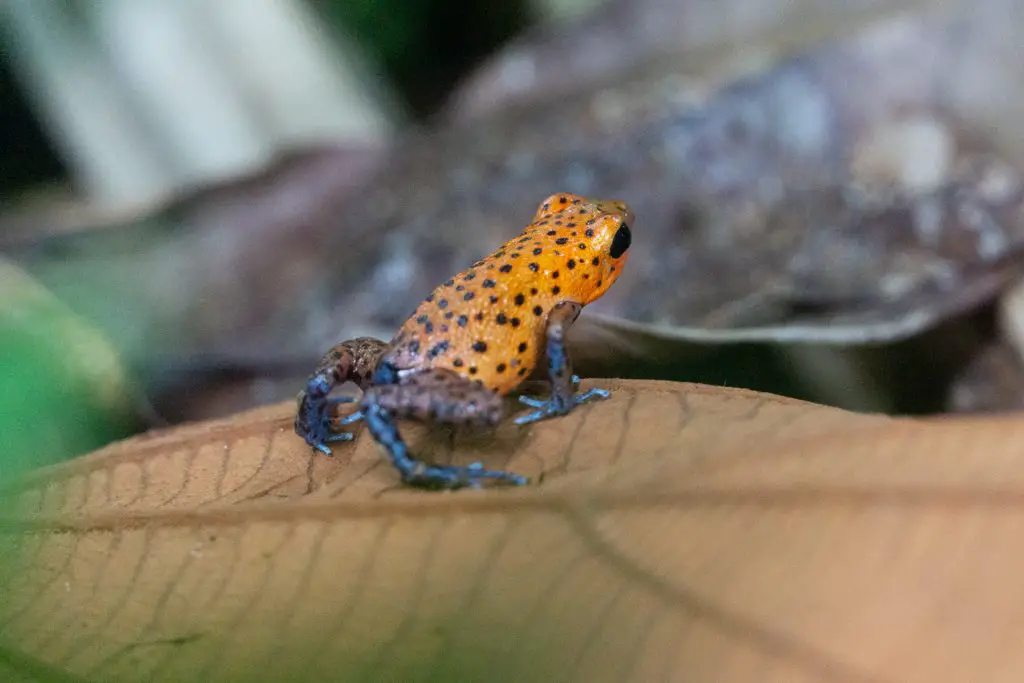
Unlike other frog species, female strawberry poison-dart frogs lay a very small amount of eggs (usually around six) in a damp place. For the first 10 days, the frogs protect the eggs by urinating on the clutch. After the eggs hatch, the female transports each tadpole one by one up a tree where they are deposited in a tiny pool of water.
Strawberry poison-dart frogs can be found in the jungles around Red Frog Beach on Bastimentos Island, Bocas del Toro. While this is one of the easiest places to find them in the archipelago, they live on several different islands and various colour morphs can be found depending on where you are.
Fun Fact: Strawberry poison-dart frogs vary hugely in colour and there are between 15-30 known colour morphs!
5. Bottlenose Dolphin
- Where: Bocas del Toro
- Conservation status: Least concern
Bottlenose dolphins are grey and can reach a length of roughly four metres. They are easily spotted in the water due to their dorsal fins which stick out when they swim close to the surface. Dolphins nearly always travel in pods so when you see one, it isn’t usually long until more pop up!
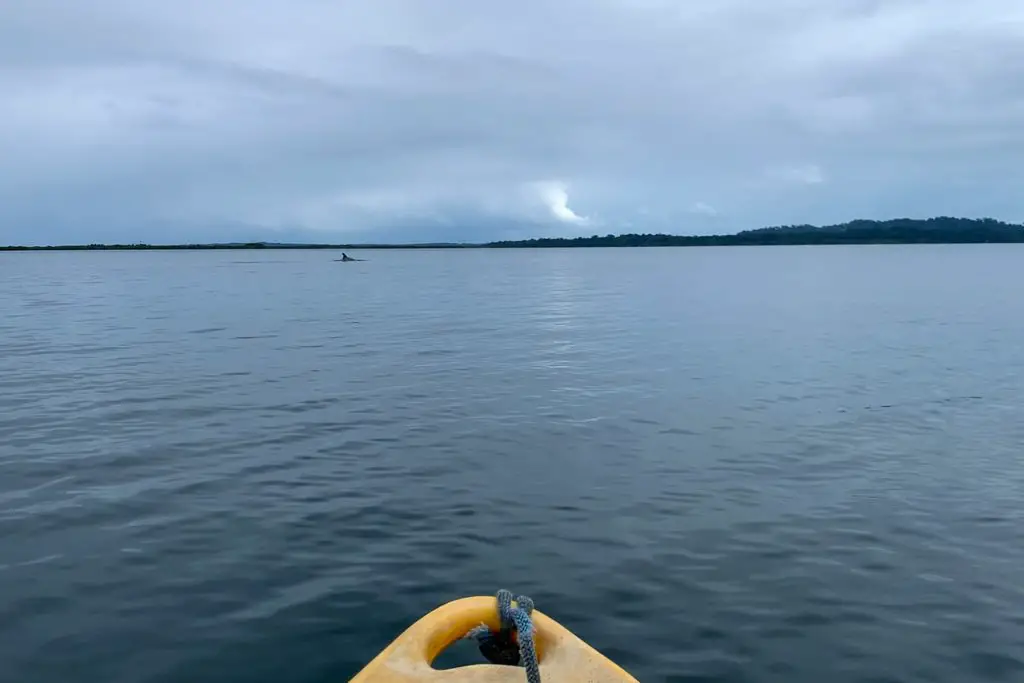
Head to Dolphin Bay in Bocas del Toro for a chance of spotting these creatures frolicking in the wild. There are bottlenose dolphins in Bocas del Toro year-round and tours to see them are offered by most of the taxi boats and hostels on the island. Sadly though, not all of these are ethical and some boats will chase the dolphins. If you can, instead rent a paddle board or kayak to get close to these beautiful aquatic creatures without disturbing them.
While bottlenose dolphins are ranked least concern in the conservation stakes, the Smithsonian Tropical Research Institute has suggested that the ones in Bocas del Toro deserve a different classification. This is because the ever-increasing number of boats has led to low numbers.
Fun Fact: Dolphins can launch themselves five metres out of the water!
6. Mantled Howler Monkey
- Where: Areas across the country
- Conservation status: Vulnerable
Panama is home to two types of howler monkeys, the Coiba Island howler and the most common, the mantled howler. The latter of these can be found in many areas across the country. Howler monkeys are commonly spotted on tours to Monkey Island which leave from Panama City. They can also be found in Sobernia National Park and Chagres National Park.

The mantled howler monkey is one of the largest monkeys in the whole of Central America and weighs over 20 lbs. Howlers are identifiable from their throaty call which can usually be heard during dawn or dusk. You’ll know if you hear a howler – it’s either a monkey or a death metal band!
Mantled howler monkeys generally live in groups of between 10-20, however, the troops can be smaller. Deforestation has led to a decline in the number of howler monkeys and as such, they are now classified as vulnerable on the conservation scale.
Fun Fact: The call of the mantled howler can be heard from up to three miles away.
7. Hawksbill Turtle
- Where: Areas across the country
- Conservation status: Critically endangered
With access to two oceans (the Pacific and the Caribbean), Panama boasts a range of diverse ecosystems. As a result, five of the seven sea turtle species in the world call the country home. One of the most beautiful is the endangered hawksbill turtle.

So-called because of its pointed beak, hawksbill turtles feed on sponges, jellyfish and anemones. On average, an adult hawksbill is likely to reach around a metre long and is recognisable by its distinct shell pattern and colour. The desire to buy these shells has led to rapidly declining numbers of hawksbill turtles; they have long been used to make luxury items such as ornaments and jewellery.
It is possible to see hawksbill turtles in Coiba National Park where they come to feed. The beaches of Bocas del Toro are popular nesting sites for them and here they are carefully protected by local conservation organisations.
Fun Fact: Hawksbill turtles are important for coral reefs to thrive. This is because they eat the sponges that compete with the corals.
8. Resplendent Quetzal
- Where: Western Panama
- Conservation status: Near threatened
If you have travelled in Latin America before, you may recognise this feathered friend – it is the national bird of Guatemala. Famous for its striking iridescent green plumage, red breast, fluffy head and trailing tail feather, the resplendent quetzal is truly a beautiful bird.

They are only found in western Panama in the areas around the Chiriqui Highlands. Boquete is a good place to spot them but you’ll need to make sure you visit at the right time of year. As a general rule, it is easier to see them during February, March and April as this is mating season. This causes them to be more active (if you know what I mean 😉).
Quetzals are fruit-eating birds which makes fruit trees a good place to start looking for them. Owing to their favourite hangout being the cloud forests, it is always advisable to keep your camera in a waterproof case too – you never know when the heavens might open!
Fun Fact: It is believed that Mayan and Aztec cultures used the feathers of the resplendent quetzal as currency.
9. Agouti
- Where: Forested areas across the country
- Conservation status: Least concern
Roughly the size of house cats, agoutis are a type of rodent creature that can be found in forested areas close to water. They look a little bit like large guinea pigs but with longer legs. Agoutis tend to be brown but some have lighter fur on their bellies.
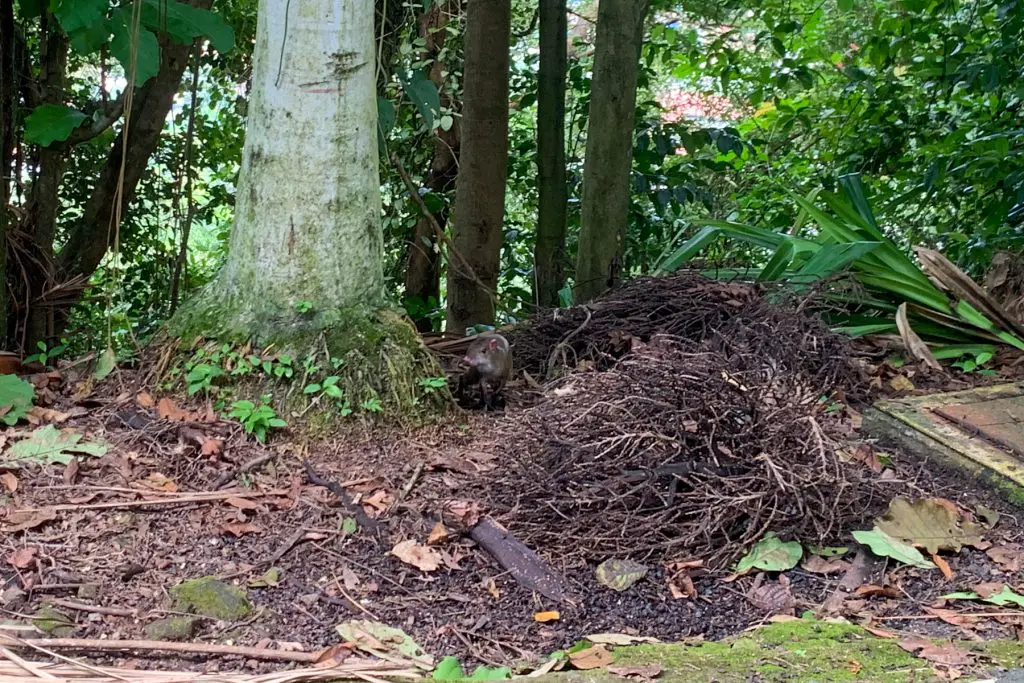
Native to the Americas, agoutis tend to live in monogamous pairs and are at their most active during the day. Despite this, they are quite shy and therefore, not always easy to spot. Agoutis are herbivores and perform an important role within the ecosystem because they scatter seeds. They also provide sustenance for predators including jaguars and eagles.
Agoutis can be spotted in many places across Panama, however, perhaps the easiest place to see them is in the Ancon Hill area. As there is no entrance fee, this is a fun cheap thing to do in Panama City.
Fun Fact: Agoutis are known as the jungle gardeners because of the way that they bury their seeds and then forget where they are!
10. Keel-Billed Toucan
- Where: Areas across the country
- Conservation status: Near threatened
For many bird enthusiasts, toucans are the bird that they are most keen to spot on their trip to Central America. Keel-billed toucans are particularly beautiful, identifiable for their black bodies, yellow neck and chest, and bright green and red bill.

While they are loved for their bright and eye-catching plumage, they can be surprisingly difficult to spot. The best way to see a toucan is to listen for its call, which sounds a little bit like those wooden croaking frogs often sold to tourists.
Keep an eye out for toucans in the areas close to the Panama Canal, Metropolitan Park, Ancon Hill and El Valle. These types of birds are very sociable so if you see one, you will usually find another close by.
Fun Fact: As well as eating berries, keel-billed toucans also sometimes indulge in snakes and lizards!
11. Spectacled Caiman
- Where: Areas across the country
- Conservation status: Least concern
The Spectacled Caiman is a type of crocodilian endemic to Central and South America. They tend to be a greenish/brownish colour and use this to blend into their boggy environment. The males are heavier than the females, however, they are all smaller than their crocodile and alligator cousins.

Although this type of caiman is not endangered, they have a long history of their skins being harvested. While this was very common in the ‘50s, spectacled caiman numbers have increased in recent years. This, coupled with the fact that they can live until they are around 70 years old, means that the species is now thriving!
Spectacled caimans are so-called because of the spectacle-like ridge which sits between their eyes. They can be found in areas all over Panama, including Bocas del Toro and Lake Gatun.
Fun Fact: Spectacled caiman mainly communicate using sound.
How many of these Panamanian animals have you seen on your travels? Share your experience in the comments section!

